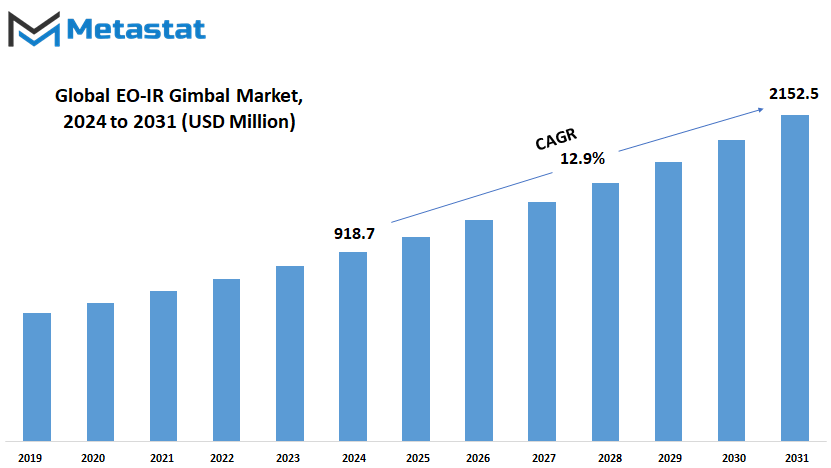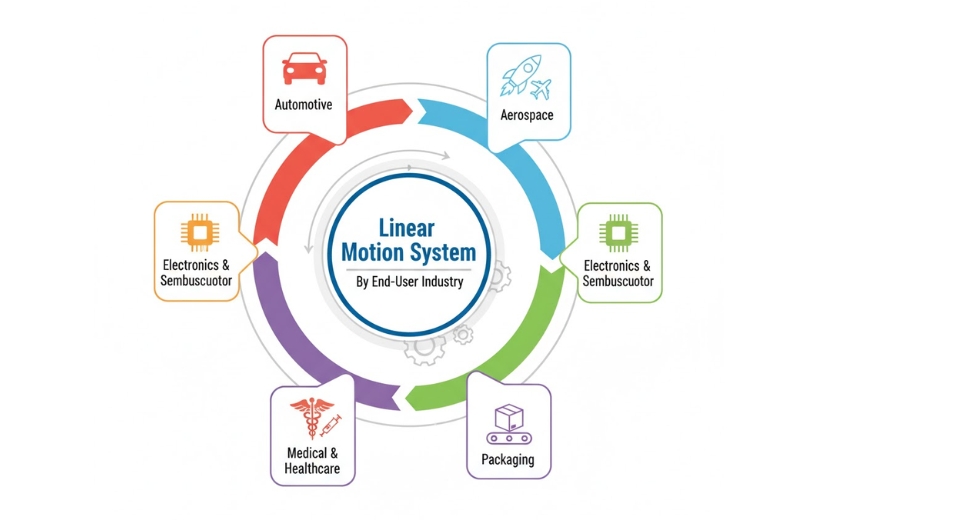MARKET OVERVIEW
The Global EO-IR Gimbal market pertains to the development and utilization of electro-optical and infrared (EO-IR) gimbals which are precision devices used for keeping sensors and cameras stabilized in place. These systems are integral to quite a number of sectors and include defense, aerospace applications, commercial surveillance, as well as maritime operations. This provides support for a broad spectrum of applications ranging from reconnaissance to navigation, monitoring to targeting. High-quality imaging, and sensor performance under trying environments are thus supported, helping the industry thrive based on growing improvements in technology and the increased demands for accurate, reliable visual data within governmental and commercial sectors.
EO-IR gimbals provide high situational awareness through advancing the integration of optical systems combined with stabilization mechanisms. This capability to maintain constant imaging during movement has made them invaluable for airborne platforms such as drones, helicopters, and aircraft, and for ground and maritime-based systems. Thus, improving operational efficiency and safety will depend on the performance of Global EO-IR Gimbals across these sectors. Whether used in border surveillance by law enforcement teams or in emergencies by rescue teams, the accuracy and reliability of EO-IR gimbals will be paramount.
Innovation and customization are hallmarks of this market. It is seen that manufacturers have been increasingly investing in lighter, energy-efficient designs and capable of meeting specific operation requirements. For example, new advancements in the defense industry are being driven by the need for compact gimbals that perform under harsh conditions. Just like this, the commercial market will focus on developing EO-IR systems with greater image resolution to meet rising requirements for high-resolution images in applications that range from infrastructure inspection and wildlife monitoring.
The geospatial reach of EO-IR Gimbal worldwide has ensured its relevance within varied geographic regions. Where the demand is rising because of increasing security concerns in some areas, others will push the market due to investment in the cutting-edge technology used for commercial applications. Further, this industry will take a turn as artificial intelligence and machine learning will enable the future integration into predictive analytics and automation within EO-IR systems. These technologies will optimize data processing and enhance the decision-making capabilities of users, ensuring that the market stays at the forefront of technological evolution.
Another critical aspect that the Global EO-IR Gimbal market focuses on is compliance and regulation. In the case of EO-IR systems, especially with defense and surveillance applications, a high level of international standards should be followed to avoid any inappropriate use. This will significantly affect manufacturing processes, trade policies, and export controls, further complicating this industry. The more technologically advanced it becomes; the more critical cybersecurity protection will be in order for these systems not to get compromised by threats.
The Global EO-IR Gimbal market represents an industry that is shaping the future of imaging and sensing technologies. Through ongoing innovation and adaptation to meet a variety of sectors’ needs, it will continue to remain an essential component of a safe, efficient, and technologically advanced world. Its emphasis on precision, reliability, and advanced capability will ensure sustained relevance in an increasingly dependent world where accurate, real-time visual data is needed.
Global EO-IR Gimbal market is estimated to reach $2152.5 Million by 2031; growing at a CAGR of 12.9% from 2024 to 2031.

GROWTH FACTORS
The Global EO-IR Gimbal market will experience a tremendous growth rate in the coming years. This is because of technological development and the growing demands from various industries. EO-IR gimbals are now an essential component of the improvement of surveillance, navigation, and imaging capabilities. Their stabilization of imaging systems and high-quality visuals have made them essential for applications in the defense, aerospace, and commercial sectors. With more modernization in technology usage globally, the world will raise its bar on the level of precision and reliability for imaging systems, thereby entrenching the EO-IR gimbals importance into many operations.
Unmanned aerial vehicles and drones have increasingly become in demand; thus, this is another important driver for the growth of the Global EO-IR Gimbal market. With the increasing use of drones for both defense and other purposes-such as search and rescue, border surveillance, amongst others-there is emerging demand for lightweight, durable high-performance EO-IR gimbals. Such gimbal systems would enable drones to generate high-resolution images and videos while operating in demanding environments - a requirement in missions mandating real-time intelligence, for instance. The increasing focus on public safety and disaster management has also incorporated EO-IR gimbals in helicopters and ground vehicles to enhance the efficiency of operations. The rapid technological developments in sensors and imaging systems add another critical dimension. The improvements in thermal imaging and high-definition cameras have much improved the functionality of EO-IR gimbals.
All of these developments address the need for far more distinct visuals and accuracy of data, particularly for applications such as infrastructure inspection, wildlife surveillance, and maritime operations. With improvement of processes in monitoring and inspection, the demand for these high-end gimbal systems will continue to rise. However, there are some challenges that may limit the growth of the market. High production costs and the requirement for periodic maintenance can be a deterrent, especially for smaller organizations or those operating in developing regions. In addition, data security and privacy issues in surveillance operations might also pose a challenge to the large-scale adoption of EO-IR gimbals.
On the bright side, the Global EO-IR Gimbal market has enormous scope for the future. Rising demand in smart cities and autonomous systems will provide avenues through which market players will evolve more complex and agile gimbal systems. The reduction of cost and improved performance will be achieved through market players, thus enabling more significant industries to participate in it for sustainable growth and innovation in years to come.
MARKET SEGMENTATION
By Type
The Global EO-IR Gimbal market is huge because it continues to advance as technologies develop, making a niche in all types of industries. EO-IR gimbals, with integrated electro-optical and infrared systems, are a key enabler for accurate imaging and tracking in dynamic environments. Because technology is developing, it's affecting all the defense, security, and commercial ventures. Understanding this gives an idea of the type of innovations that will take shape and how they will change the game of imaging and surveillance in the future.
The main difference between EO-IR gimbals is classified into two categories: 2-axis and 3-axis, depending on their axis setup. The 2-axis EO-IR gimbals provide stabilized motion in the two axes of movement; this provides an image for most operations that require a simple, but sure setting. They find wide usage where design weight and size are key factors, as in smaller drones or hand-held surveillance systems. On the other hand, 3-axis EO-IR gimbals provide an additional level of stabilization since they manage motion in three axes. This architecture provides increased accuracy, which is perfect for high-altitude drones, manned aircraft, or maritime applications where stability and high-quality imaging are required.
As unmanned systems and autonomous technologies continue to gain more traction among industries, the demand for EO-IR gimbals is likely to increase. This is highly noticeable in agricultural usage, inspection of infrastructure, and environmental monitoring by utilizing drones. EO-IR gimbals allow the respective platforms to capture imagery and thermal data in high resolution under conditions that will be very challenging to other sensors while giving them invaluable insights. To the defense, it is the importance of such systems as reliance on these systems grows for intelligence, surveillance, and reconnaissance missions because real-time situational awareness in unpredictable environments will be required.
The future of the Global EO-IR Gimbal market will be miniaturized, with improved power efficiency and enhanced sensor capabilities. Such advancements will not only increase their usability but also reduce operational costs, making them accessible to a wider range of industries. Emerging technologies, such as artificial intelligence, may further enhance gimbal performance by enabling autonomous adjustments and advanced target tracking.
With growing needs for precision and reliability, EO-IR gimbals will continue to play an increasingly vital role in addressing modern imaging and surveillance challenges. This is important as a cornerstone of technological progress that reflects a future where their applications are not only widespread but also transformative.
By End User
The Global EO-IR Gimbal market is gradually growing and is on the verge of great development over the next few years. EO-IR gimbals are highly critical systems which add a high degree of surveillance, reconnaissance, and targeting capabilities for any organization or business. The device can be mounted on a platform; they aid in stabilizing optical and infrared cameras for capturing the accurate data even in motion. With the growing use of unmanned systems and advanced defense technologies, the market for these gimbals is likely to grow even further, meeting the needs of different end users.
The market is divided into end users such as UAV/UAS (Unmanned Aerial Vehicles/Systems), defense, marine, law enforcement, and others. UAVs and UAS have already revolutionized operations in sectors like agriculture, emergency response, and military surveillance. EO-IR gimbals are critical components of these aerial systems, ensuring that they operate precisely in all environments, particularly where stable imagery and accurate data are critical. Another important sector that utilizes these systems is the defense sector, which will most likely increase demand for the advanced targeting systems and monitoring technologies. As countries continue modernizing their defense infrastructure, the use of EO-IR gimbals on drones, helicopters, and other platforms will increase.
These applications at sea also reveal the crucialness of these systems. EO-IR gimbals mounted on vessels and other watercraft improve navigation and situational awareness in low-visibility situations. Law enforcement also employ such technologies for search-and-rescue operations, border watch, and crowd monitoring. Industrial inspection and wildlife conservation also envision deployment of EO-IR gimbals because of special capabilities they provide.
By type, the market caters 2-axis and 3-axis EO-IR gimbals. 2-axis systems offer stable imaging, as it controls movement on two axes; 3-axis gimbals go a step further in stability by introducing control on a third axis. The advancement of such systems plays a significant role in capturing sharp visuals and providing accurate data in dynamic situations. Future trends will include more innovations. These systems will use lighter material and smarter technology that will improve the efficiency of the system.
With the advent of highly advanced data collection and surveillance solutions within industries, the Global EO-IR Gimbal market will find an increase in its new prospects. Continued research and development investment, along with technological advancement, pushes forward this market to bring applications into existence that are critical to both security and innovation.
|
Forecast Period |
2024-2031 |
|
Market Size in 2024 |
$918.7 million |
|
Market Size by 2031 |
$2152.5 Million |
|
Growth Rate from 2024 to 2031 |
12.9% |
|
Base Year |
2022 |
|
Regions Covered |
North America, Europe, Asia-Pacific Green, South America, Middle East & Africa |
REGIONAL ANALYSIS
EO-IR Gimbal Market: Expanding and Diversifying The market for EO-IR gimbals is growing and diversifying rapidly. The technology continues to evolve and advance, and gimbals now offer precision targeting and stabilization in both electro-optical and infrared applications. The technology has become indispensable to many industries, such as defense, security, and surveillance, where clear images, stable even under the most adverse conditions, are of great importance.
As is indicated by the regional analysis, this global EO-IR Gimbal market is not equal in all regions in its adoption of these technologies. North America is an example major contributor to the market with U.S., Canada, and Mexico under it. The majority integration in the use of high technologies lies in the U.S. which in return gets most of its applications mainly on EO-IR gimbals from defense. Canada and Mexico also take part, although smaller markets but still growing ones, with a continuously growing number of interested security agencies and spreading systems.
The market in Europe is further bifurcated into countries such as the UK, Germany, France, Italy, and the rest of the region. Demand for EO-IR gimbals in the European region is created by government and commercial sectors. European nations are focused on modernizing their defense systems that include drones and unmanned vehicles, and these require stable and high-performance EO-IR gimbals. Moreover, environmental monitoring and border security of Europe creates a huge demand for this market.
Asia-Pacific, with countries such as India, China, Japan, and South Korea, will see some of the highest growth in the market. China, for example, is making large investments in defense and security, and this is driving the demand for high-quality EO-IR gimbals. India and Japan, having significant defense budgets, are also embracing these technologies to improve their military capabilities and surveillance systems.
South America has been developing steadily, and Brazil and Argentina have been at the forefront. This growing need for border control and defense systems in those regions will create increased demand for EO-IR gimbals in the next years.
Finally, there is the Middle East & Africa region that includes GCC nations, Egypt, South Africa, and other countries with high interest in EO-IR gimbals. The regional conflicts and security concerns are likely to increase the demand for high-performance gimbals.
This global EO-IR Gimbal market will continue to expand in all regions as technology improves and demand increases, and each region will adapt the systems to meet local needs and challenges. The future of this market looks very promising with huge opportunities for innovation and growth.

COMPETITIVE PLAYERS
The Global EO-IR Gimbal market is advancing at a rapid pace due to the increasing demand for advanced surveillance and tracking systems. With the requirement of advanced technologies in industries ranging from defense to aerospace, EO-IR gimbals are an essential part of modern equipment. The best imaging gimbals integrate optical and infrared systems to capture images in clear visibility, ranging from daylight to the darkest night. Such technology is only bound to grow with many players who will be contributing to this market expansion.
Key players in the EO-IR gimbal market have been continually pushing the boundaries of technology. Companies such as AeroVironment Inc. and L3Harris Technologies Inc. lead the field, offering state-of-the-art solutions both to the commercial and military marketplaces. Adding these gimbals with UAVs altered the number of today's missions, ranging from surveillance to reconnaissance, among other applications. Major players such as Teledyne FLIR LLC and Leonardo DRS provide specific products dealing with harsh environments and extreme conditions. Their designs stress reliability and accuracy, which these EO-IR systems used on critical applications need.
As competition picks up slowly, companies like Merio - UAV Payload Systems and Ukrspecsystems find grounds in offering niche market-specific products. This is because a company's unique offerings mean that it meets specific customer requirements such as having a more compact design or even a system that can remain operational for longer periods. This diversity within the market allows customers to make choices that best fit the requirements of their operations.
Looking ahead, it is pretty clear that the demand for EO-IR gimbals is only going to increase from here. Growing global defense spending and an increasing tendency to rely on unmanned systems for surveillance are going to fuel the need for these high-performance gimbals. Players like Lockheed Martin Corporation and CACI International Inc. will be making this market appear to be this future. That's because both of these companies possess experience and resources in that their competitive edge will only sustain in the context of just how complex and dynamic a landscape could become. What they do will probably lead into the more advanced, more compact yet efficient systems that will revolutionarily reshape just how EO-IR gimbals get used in pretty much many industries. The competitive nature of this market assures a continued development that makes the future of EO-IR technology even brighter.
EO-IR Gimbal Market Key Segments:
By Type
- 2-Axis EO/IR Gimbals
- 3-Axis EO/IR Gimbals
By End User
- UAV/UAS
- Defense
- Marine
- Law Enforcement
- Others
Key Global EO-IR Gimbal Industry Players
- AeroVironment Inc.
- Innovative Intuitive Technology Inc.
- L3Harris Technologies Inc.
- Leonardo DRS
- Merio - UAV Payload Systems
- Teledyne FLIR LLC
- Ukrspecsystems
- CONTROP Precision Technologies Ltd.
- Harris Aerial
- Lockheed Martin Corporation
- CACI International Inc (Ascent Vision Technologies, LLC)
WHAT REPORT PROVIDES
- Full in-depth analysis of the parent Industry
- Important changes in market and its dynamics
- Segmentation details of the market
- Former, on-going, and projected market analysis in terms of volume and value
- Assessment of niche industry developments
- Market share analysis
- Key strategies of major players
- Emerging segments and regional growth potential







 US: +1 3023308252
US: +1 3023308252






